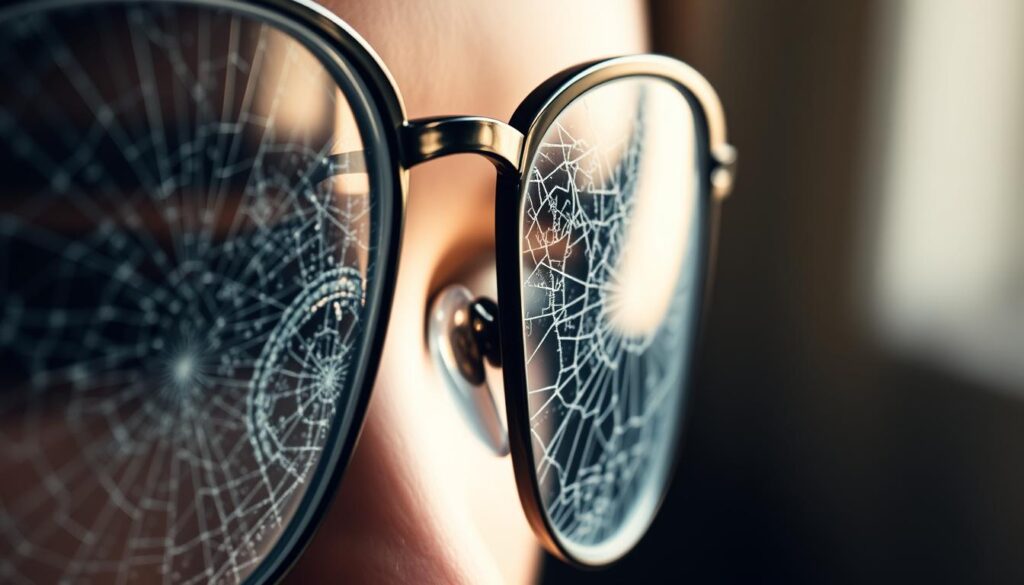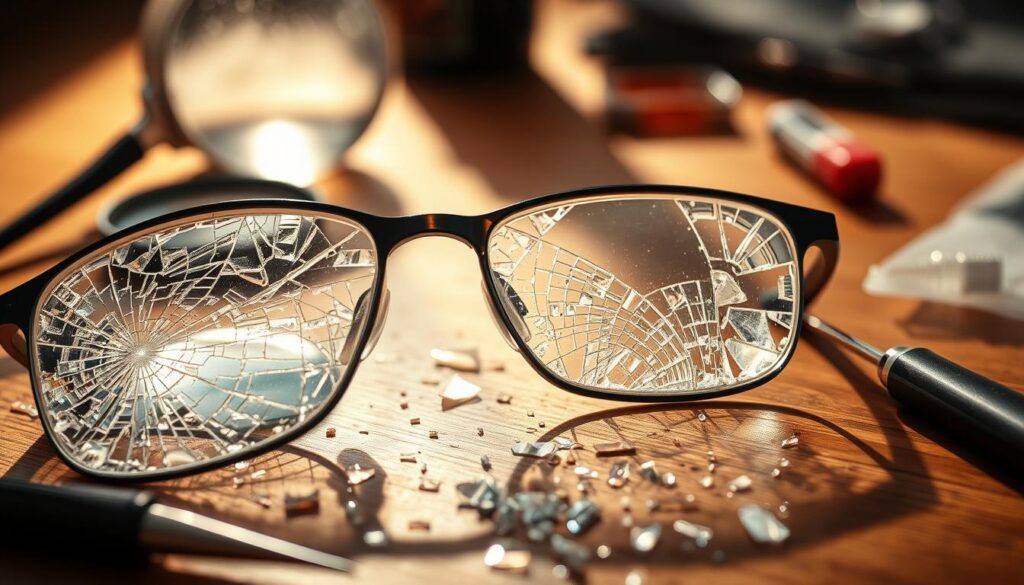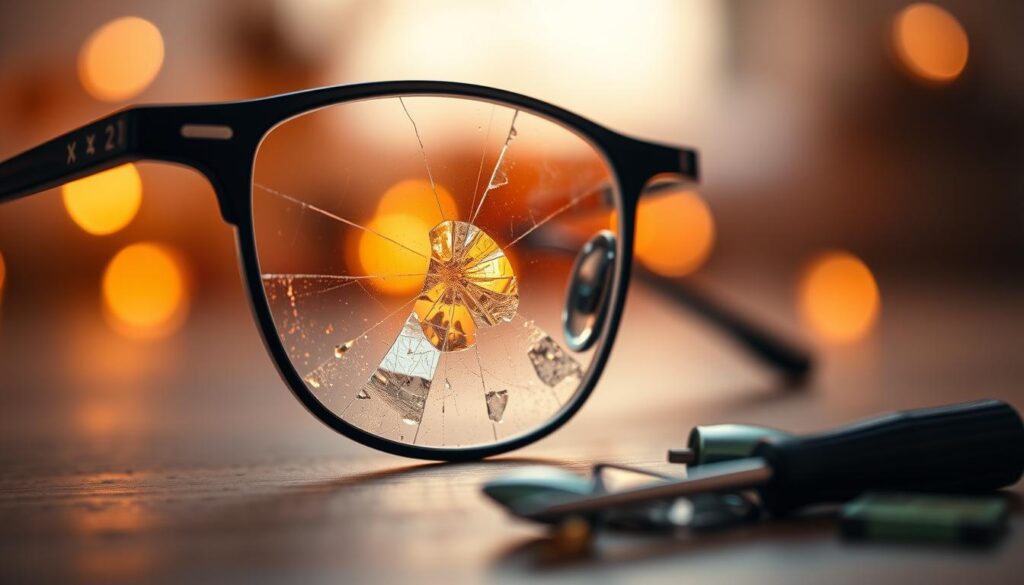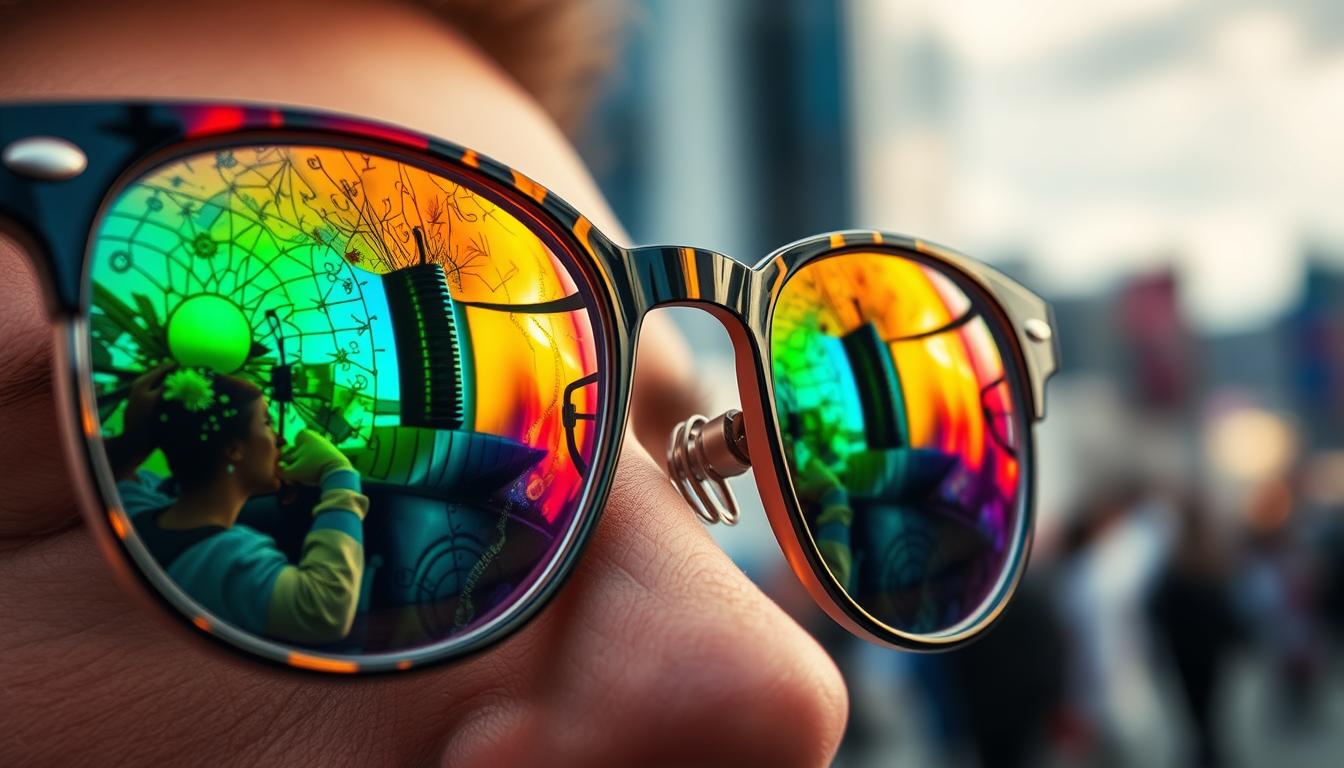Introduction
Have you ever had to deal with crazed glasses lenses or cracked eyewear glass? This problem can make your vision blurry and cause eye strain. It’s important to find a good way to fix or replace them.
Understanding why your glasses get crazed is key. Things like chemicals, temperature changes, and physical stress can harm them. Knowing this helps you prevent more damage and find the right fix for your glasses.
Key Takeaways
- Identify the causes of crazed glasses lenses, such as chemical exposure and physical stress
- Understand the importance of finding a reliable and efficient repair or replacement solution
- Consider the various types of lens damage patterns and their impact on vision quality
- Learn about the factors that contribute to crazed glasses lenses, including temperature fluctuations
- Discover the best options for replacing or repairing crazed glasses lenses or cracked eyewear glass
- Take steps to prevent further damage and maintain the quality of your vision
Understanding Crazed Glasses Lenses: What Causes This Issue
Crazed glasses lenses can be really frustrating. They can make your shattered spectacles lenses and hurt your vision. To fix this, we need to know why it happens.
Chemical exposure is a big reason. It can make the lens material weak and cause crazing. This happens when lenses meet harsh cleaning products or certain chemicals in the air.
Temperature changes also play a big part. When the temperature goes up and down, the lens material expands and contracts. This stress can cause cracks and crazing, making your damaged eyeglass lenses worse. Dropping or bending your glasses can also damage them.
Chemical Exposure Effects
Chemicals can really harm your glasses lenses. Cleaning products or pesticides can get into the lens and damage it. This can make your lenses discolored, brittle, and crazed.
Temperature Fluctuation Impact
Temperature changes can also hurt your glasses lenses. Extreme temperatures can make the material expand and contract. This stress can damage the lens, which is a big problem for certain materials like polycarbonate or Trivex.

Physical Stress Factors
Physical stress, like dropping or bending your glasses, can also cause crazing. This can make the lens crack or shatter, leading to shattered spectacles lenses and bad vision. To avoid this, be gentle with your glasses and keep them away from harsh chemicals and extreme temperatures.
Different Types of Lens Damage Patterns
Lens damage can take many forms, like cracks, chips, and scratches. These issues arise from various factors, such as the lens’s material, thickness, and shape. It’s vital to inspect and diagnose the damage properly to decide on the best broken lens repair or replacement.
Some common lens damage types include:
- Cracks: These happen due to physical stress or impact. They can be fixed or replaced, depending on how bad they are.
- Chips: These are small cracks on the lens’s edge. They can be repaired or replaced.
- Scratches: Caused by daily wear and tear, they can be fixed or replaced based on their severity.
It’s important to fix lens damage quickly to avoid more harm and keep your vision clear.

In some cases, you might need a professional broken lens repair or a new lens. Always talk to an optician or eye care expert to figure out the best solution for you.
| Type of Damage | Cause | Repair/Replacement |
|---|---|---|
| Cracks | Physical stress or impact | Depends on severity |
| Chips | Physical stress or impact | Depends on severity |
| Scratches | Everyday wear and tear | Depends on severity |
Signs Your Glasses Lenses Are Beginning to Craze
Do you see anything odd or feel uncomfortable when wearing your glasses? It might mean your lenses are crazing. This could happen due to chips or scratches.
Look out for distortion, blur, and double vision. These signs can mess up your day and make life harder. If you see these, get help from an expert.
Visual Indicators
- Distortion: blurred or wavy lines
- Blur: unclear or hazy vision
- Double vision: seeing two images instead of one
Physical Symptoms
Eye strain, headaches, and feeling tired can also be signs. These symptoms can make you feel really bad.

Impact on Vision Quality
Crazed lenses can really mess with how well you see. They can make things look less clear, colors off, and contrast poor. If you’re seeing these problems, it’s time for a new lens.
Spotting these signs early can help you fix the problem. This way, you can keep your vision clear and comfortable.
Top Materials for Replacement Crazed Glasses Lenses
Choosing the right material for replacing crazed glasses lenses is key. Polycarbonate and Trivex are top picks for their toughness and scratch resistance. Yet, they might not be the best for those who value clear vision most.
High-index materials are a better fit for those seeking top-notch optical quality. They offer a thinner, lighter lens that doesn’t compromise on clarity.
When picking a material for shattered lenses, think about what you need. If you have a strong prescription, high-index materials are a must for clear vision. But if you want something durable and easy on the wallet, polycarbonate or Trivex could be the way to go.

High-index materials bring several advantages to the table for fixing shattered lenses:
- They’re thinner and lighter
- They offer better optical clarity
- They’re more durable
Talking to an optician is vital to find the perfect material for your new lenses. They’ll consider lens thickness, curvature, and coatings to make the right choice for you.
Comparing Different Lens Technologies
When looking to replace crazed glasses lenses, you have many options. Each has its own benefits and drawbacks, like weight, thickness, and how clear they are. For example, polycarbonate lenses are popular for their lightness and ability to withstand impacts.
Polycarbonate Options
Polycarbonate lenses are durable and resistant to scratches. They’re great for kids’ glasses or for jobs where eye safety is key.
High-Index Materials
High-index lenses are thinner and lighter than usual lenses. They’re perfect for those with strong prescriptions who want a lens that looks good.
Trivex Alternatives
Trivex lenses are made from a special plastic that’s both light and tough. They’re a good pick for those who want a durable yet comfy lens. For those fixing cracked lenses, Trivex could be a solid choice. It offers clear vision and durability, making it a great option for crazed glasses lenses.
Professional Repair vs. Replacement Options
When your eyewear glass gets cracked or your spectacles lenses shatter, you have to think about repair or replacement. The damage’s extent, lens material, and repair or replacement costs are key. For small cracks, repair might work. But for big damage, it’s better to replace them.
Getting help from an optician or eye care expert is important. They can check the damage and tell you the best way to fix it. Regular maintenance and proper care can also prevent future damage. Here are some things to think about when choosing between repair and replacement:
- Cost: Repairing can save money if the damage is small.
- Convenience: New lenses are ready fast, while repair takes longer.
- Quality: New lenses offer better clarity and quality.
Sometimes, repair isn’t an option, and you must replace the lenses. This is true for big damage or complex prescriptions.
The choice between repair and replacement depends on your situation. Think about the factors mentioned and talk to an eye care professional. This way, you can make a choice that fits your needs and budget.
Cost Analysis of Lens Replacement Solutions
When dealing with damaged eyeglass lenses, it’s key to think about the cost of replacement. The price to fix or replace broken lenses can change based on several things. This includes the lens material and how complex the fix is.
Several factors can affect the cost of replacing lenses. The location and the eye care professional’s reputation are important. It’s also vital to think about the long-term costs and benefits of replacing lenses. This includes the chance of needing more repairs or replacements in the future.
- Budget options: These may include basic lens replacement or repair services, which can be more affordable but may not offer the same level of quality or durability.
- Premium alternatives: These may include high-end lens materials or advanced repair techniques, which can provide better quality and durability but at a higher cost.
- Insurance coverage possibilities: Some insurance plans may cover part or all of the cost of lens replacement or repair, depending on the specific policy and provider.
It’s important to compare the costs and benefits of each option. Think about the lens material, the repair complexity, and the optician’s reputation. By doing this, you can make a smart choice for your damaged eyeglass lenses and broken lens repair needs.
| Option | Cost | Benefits |
|---|---|---|
| Budget | Affordable | Basic lens replacement or repair |
| Premium | Higher cost | High-end lens materials or advanced repair techniques |
| Insurance | Varies | Part or all of the cost may be covered |
Preventing Future Lens Crazing
To stop lens crazing, take good care of your glasses. This means regular cleaning and upkeep, how you handle and store them, and avoiding harsh chemicals or extreme heat. These actions help keep your lenses safe and reduce the chance of needing chipped glasses lens replacement.
Here are some tips to stop lens crazing:
- Always handle your glasses with care, avoiding drops or bumps that can cause damage.
- Store your glasses in a protective case when not in use to prevent scratches and other damage.
- Avoid exposing your glasses to harsh chemicals or extreme temperatures, which can cause lens crazing.
- Regularly inspect your lenses for signs of damage or wear, and seek professional help if you notice any issues.
By following these tips, you can make your glasses last longer and cut down on chipped glasses lens replacement needs. Always be gentle with your glasses and take steps to avoid damage. This way, you can enjoy clear and comfortable vision for many years.
Maintenance Tips for Extended Lens Life
To keep your glasses lenses in good shape, follow a daily care routine. Clean them gently with a soft cloth. Stay away from harsh chemicals that can scratch or damage them. For a scratched lens fix, use a microfiber cloth and a mild cleaning solution. Regular cleaning can prevent the need for shattered spectacle lens restoration.
Some cleaning products are best avoided. These include harsh chemicals like bleach or ammonia. Also, avoid abrasive materials like paper towels or rough cloths. And steer clear of chemicals with acetone or other solvents.
- Harsh chemicals like bleach or ammonia
- Abrasive materials like paper towels or rough cloths
- Chemicals that contain acetone or other solvents
Proper storage is also key. Store your glasses in a protective case when not in use. Avoid leaving them in direct sunlight or extreme temperatures.
By following these tips, you can extend your glasses lenses’ life. Handle them with care and avoid harsh chemicals or extreme temperatures. With the right care, your glasses lenses can last for many years, giving you clear and comfortable vision.
| Storage Recommendations | Cleaning Products to Avoid |
|---|---|
| Store glasses in a protective case | Harsh chemicals like bleach or ammonia |
| Avoid direct sunlight or extreme temperatures | Abrasive materials like paper towels or rough cloths |
Emergency Solutions for Temporarily Fixing Crazed Lenses
In emergency situations, you can try temporary fixes for crazed lenses. Cracked lens refurbishment might be an option, but it’s important to know its limits and risks. These fixes can help in the short term but might not last forever.
Some emergency solutions for fixing crazed lenses include:
- Using a lens cleaning kit to remove dirt and debris
- Applying a temporary lens coating to reduce glare
- Utilizing a lens repair kit to fix minor cracks
Keep in mind, these solutions are not a permanent fix. If your lens is crazed, get help from an optician or eye care professional right away.
Having a backup pair of glasses or a spare lens is helpful in emergencies. It ensures you have working glasses while you wait for a cracked lens refurbishment or a permanent replacement.
Remember, temporary fixes are only a quick solution. For a lasting fix, talk to an eye care professional. They can guide you on the best steps for your situation.
When to Seek Professional Help
Dealing with crazed glasses lenses or cracked eyewear glass can be frustrating. It affects your daily life. Knowing when to seek professional help is key to prevent further damage and ensure your eye health.
If you’re experiencing vision problems, eye strain, or physical symptoms, it’s time to consult an expert. A qualified optician or eye care professional can assess your lenses. They can guide you on the best action to take.
They can tell you if your crazed glasses lenses can be repaired or if you need a replacement. Don’t hesitate to seek help if you notice any warning signs. These include blurred vision, headaches, or eye fatigue.
Warning Signs
- Vision problems, such as blurred or distorted vision
- Eye strain or fatigue
- Physical symptoms, like headaches or eye pain
Finding Qualified Opticians
To find a reputable optician, look for online reviews and ask for referrals. Check their credentials too. A professional optician can help you find the perfect replacement for your crazed glasses lenses or cracked eyewear glass.
Remember, seeking professional help is vital for your eye health. Don’t wait until it’s too late. Consult an expert today and get the help you need to see the world clearly again.
Conclusion
Shattered spectacles lenses and damaged eyeglass lenses can be really frustrating. But, with the right knowledge, you can protect your vision and keep your glasses in good shape. Knowing the causes of lens crazing and spotting early signs helps a lot.
Choosing the right replacement or repair is also key. This way, you can have clear, comfortable vision for a long time.
It’s important to talk to a qualified optician or eye care professional about your eye health. They can give you personalized advice and check your lenses. With their help and your care, your glasses will stay in great condition. You’ll enjoy clear vision for many years.
FAQ
What causes crazed glasses lenses?
Several things can cause crazed glasses lenses. Chemicals, like cleaning products or cosmetics, can damage the lens materials. Extreme temperatures, both hot and cold, can also cause cracks. Physical stress, like dropping the glasses, can lead to damage.
What are the different types of lens damage patterns?
Glasses lenses can get damaged in different ways. Cracks can happen from stress or temperature changes. Chips usually come from impacts. Scratches can result from wear and tear, bad cleaning, or abrasive surfaces.
How can I tell if my glasses lenses are starting to craze?
Signs of crazing include distortion, blur, and double vision. You might also feel eye strain or headaches. Poor vision quality, like reduced clarity and color, can also indicate crazing.
What are the best materials for replacement crazed glasses lenses?
The best materials for new lenses are polycarbonate, Trivex, and high-index. Each has its own strengths and weaknesses. When choosing, think about thickness, curvature, and coatings for the best fit.
How do I prevent future lens crazing?
To avoid crazing, clean lenses gently and handle them carefully. Store them properly and avoid harsh chemicals and extreme temperatures. Regular checks can catch problems early and prevent damage.
When should I seek professional help for crazed glasses lenses?
If you notice vision problems, eye strain, or physical symptoms, see an optician. They can diagnose and advise on care to prevent further damage.
